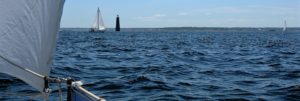President Obama favored lobstermen before solar-cell industrialists when he protected a 4,900 square mile ocean refuge 150 miles east of Cape Cod. The Antiquities Act was used to go around a grid-locked Congress to establish the Northeast Canyons and Seamounts National Marine Monument. The designated ocean wildlife refuge features three canyons (Oceanographer, Gilbert, and Lydonia Canyons) incised into the continental shelf on the south side of Georges Bank, and four seamounts (Bear, Physalia, Mytilus, and Retriever) that rise up ten thousand feet off the Atlantic Ocean’s abyssal floor. Permanently protected are seven sea places – essential ocean habitats like no other.
The solar-cell industry has expressed interest in mining these seamounts. Summits of the four volcanic seamounts are more than one thousand feet below the surface, in complete darkness. Seamounts are made of hard basalt rock with a remarkable porosity of 60%. Gnarly with much surface areas, seamounts sponge out of seawater rare earth minerals (cerium, europium, lanthanum, and yttrium) and high tech metals (tellurium, cobalt, bismuth, zirconium, niobium, tungsten, molybdenum, platinum, titanium, and thorium).
High tech metals are refined and combined into alloys. Tellurium combined with bismuth becomes an alloy that is being tested as a next-generation computer chip that is more efficient and immensely faster than existing chips. Tellurium is combined with cadmium into an alloy that is considered the best material for production of multi-terawatt solar-cell electricity using thin-film photovoltaic technology.
Ancient seamounts in the mountains of China are currently being mined. China refuses to export rare earth minerals and high tech metals. Companies must instead manufacture in China. Similar mines could be opened in Californian mountains, where many new jobs would be costlier for industry. Thus the president acted to make sure the wrecking ball of high-tech metal mining will never destroy the unique assemblages of marine life living deep below on Bear, Physalia, Mytilus, and Retriever Seamounts.
The ocean refuge has also been protected from overfishing. Prohibited are trawling and purse seining for Loligo squid, whiting, and mackerel, and dredging for scallops and shellfish. Out over the seamounts, gill netting and long lining for swordfish, yellow fin and skip jack have been banned.
Unprecedented for a national park or refuge, some people of this seascape may stay and continue to work there. (For them, there will be no mustering of a Mariposa Battalion.) For seven years, lobstermen are permitted to trap lobsters on the ribbon of ocean floor less than 500 meters deep that wraps the northern ends of the three ocean canyons and connects the intervening continental slope waters.
Unable to see beneath the sea’s face, for the most part, there is no more immediate reassurance of a healthy ocean than a working lobster boat. Though the wood pot frames invented by Ebenezer Thorndike in Swampscott (1808) have been replaced by plastic-coated metal, the pursuit of lobsters has not changed over the generations. These deep water trappers are the undersea canyon rangers. With intimate knowledge of this ocean realm, they are the eyes on the resource. At no public expense, these watchmen serve far offshore on a continental frontline under assault by the effects of Global Warming.

Port tack offshore of Minot’s Ledge Light, Scituate, Massachusetts